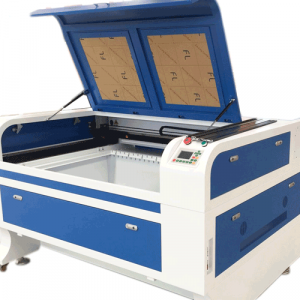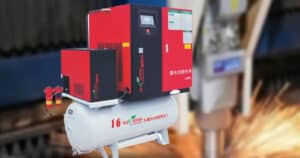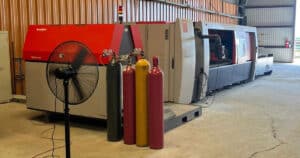Under the global theme of energy-saving and new energy utilization, how can China’s industrial manufacturing come out of the green road of environmental protection and energy-saving? we would like to learn more about the contribution of laser technology in environmental protection and industrial green development now.
Laser is a faithful partner to achieve carbon peaking and carbon neutrality
Laser is one of the major inventions of the 20th century, which has four characteristics: high brightness, good monochromaticity and coherence, and directionality. Because laser processing is contactless processing, no direct impact on the workpiece, so no mechanical deformation, no impact noise; laser processing process without “tool” wear, no “cutting force” on the workpiece; laser processing process, the high energy density of the laser beam, processing speed, and local processing, no or minimal impact on non-laser irradiated parts. Laser processing process of high energy density, processing speed, and is local processing, non-laser irradiation parts have no or minimal impact. Therefore, the heat-affected zone is small, the heat deformation of the workpiece is small, and the subsequent processing is minimal. Because the laser beam is easy to guide, focus and realize direction change, it is very easy to work with the CNC system to process complex workpieces.
Therefore, laser processing is an extremely flexible and convenient processing method with high production efficiency, stable and reliable processing quality, and good economic and social benefits. Without chemical pollution and environmental pollution, it is a faithful partner to achieve carbon peaking and carbon neutrality.
Laser cleaning is quite an environmentally friendly cleaning technology
With the progress of science and technology, people gradually explore a variety of technologies conducive to environmental protection, laser cleaning technology is one of them.
Laser cleaning is the use of a high-energy laser beam and the surface of the workpiece to remove the material interaction so that the adhesion of instantaneous evaporation or stripping to achieve the purpose of cleaning the workpiece. This processing technology does not require various chemical cleaning agents, green and non-polluting. And the scope of application is very wide, mainly applied to the surface paint stripping treatment, surface oil, stains, dirt cleaning, surface plating, coating removal, welding surface/spray surface pretreatment, stone statue surface dust, and adhesion removal, rubber mold residue cleaning, etc.
Traditional cleaning methods including mechanical cleaning method, chemical cleaning method and ultrasonic cleaning method will produce pollutants to varying degrees, in environmental protection and high precision requirements of its application is greatly restricted. The laser cleaning process will not occur any harmful substances, can be called quite environmentally friendly cleaning.
Compared with traditional cleaning methods, laser cleaning is a “green” cleaning method, has unparalleled advantages: no need to use any chemicals and cleaning solutions, cleaning down the waste is basically a solid powder, small size, easy to store, adsorption recovery, no photochemical reaction, will not produce noise and environmental pollution. At the same time does not damage the health of the operator, easy to achieve automatic control, to achieve remote control cleaning.
The environmental contribution of fiber laser technology
As one of the most promising new technologies of the 21st century, laser technology is also playing an important role in cleaning up the environment on which we depend. The emergence and application of lasers have been called the third leap in the use of human tools. In order to meet the needs of manufacturing transformation and upgrading, laser technology will lead the manufacturing industry into the direction of high efficiency, energy saving, environmental protection and intelligence.
Fiber lasers have high efficiency of electro-optical conversion, compared with different lasers, in terms of electro-optical conversion rate: fiber lasers reach 30%, YAG solid-state lasers only 3%, CO2 lasers 10%; traditional lasers in the gain medium must normally be water-cooled. The fiber laser uses fiber as the gain medium, which has a large surface area/volume ratio, which makes it have very good heat dissipation performance. At the same time, the closed all-fiber structure ensures the stability of the laser cavity. Because of these unique features of fiber lasers, which makes its cooling requirements greatly reduced, low-power fiber lasers only need to use air cooling, replacing the water cooling requirements necessary for traditional lasers, thus saving electricity and water, and contributing to energy saving and emission reduction.
Laser integrates energy saving, environmental protection, emission reduction, and low carbon
In recent years, laser processing, as an advanced processing method, has gradually replaced a variety of traditional processing methods. In the fields of marking, welding, cutting, cleaning, cladding, and additive manufacturing, laser processing has gradually shown its unparalleled advantages.
Such as with the development of the times a variety of laser cleaning technology conducive to environmental protection came into being; such as LIDAR, can accurately analyze the geographical location of the source of pollution, pollution area, the frequency of occurrence, presume the source of pollution and pollution causes, effectively enhance the efficiency of air pollution management; there is a higher efficiency than traditional methods, and lower cost of laser removal; there are brighter than LED lights, while smaller, more energy-efficient, irradiation There are laser lighting, which is brighter than LED lights, and at the same time smaller, more energy-efficient, farther irradiation distance and more power-saving; there is also the alternative plating technology, which has now become the industry consensus, and its low-cost, zero pollution, long life and low energy consumption are recognized by the market, such as laser cladding technology, all of which are low-carbon technologies for energy saving, environmental protection and emission reduction.
Achieving carbon peak and carbon neutral is an inherent requirement for promoting high-quality development, which should be correctly understood and firmly promoted. To this end, we should unswervingly take the high-quality development path of ecological priority, green and low-carbon, seize the key period and window period of the 14th Five-Year Plan to reach the carbon peak, resolutely take up the political responsibility of environmental protection, take the initiative, and actively work to make new contributions to accelerate the construction of the beautiful Greater China with blue sky, beautiful land, and pure water.







